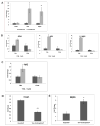Nrf2 signaling is impaired in the aging RPE given an oxidative insult
- PMID: 24216314
- PMCID: PMC3946784
- DOI: 10.1016/j.exer.2013.10.024
Nrf2 signaling is impaired in the aging RPE given an oxidative insult
Abstract
Age-related macular degeneration (AMD) represents the leading cause of blindness in the elderly, yet no definitive therapy exists for early, dry disease. Several lines of evidence have implicated oxidative stress-induced damage to the retinal pigment epithelium (RPE) in the pathogenesis of AMD, suggesting that the aging RPE may exhibit increased susceptibility to cell damage induced by exogenous stressors. The transcription factor Nrf2 serves as the master regulator of a highly coordinated antioxidant response in virtually all cell types. We compared Nrf2 signaling in the RPE of young (2 months) and old (15 months) mice under unstressed and stressed (sodium iodate) conditions. The aging RPE expressed higher levels of the Nrf2 target genes NQO1, GCLM, and HO1 compared with the RPE of younger mice under unstressed conditions, suggesting an age-related increase in basal oxidative stress. Moreover, the RPE of older mice demonstrated impaired induction of the protective Nrf2 pathway following oxidative stress induced with sodium iodate. The RPE of old mice exposed to sodium iodate also exhibited higher levels of superoxide anion and malondialdehyde than young mice, suggesting inadequate protection against oxidative damage. Induction of Nrf2 signaling in response to sodium iodate was partially restored in the RPE of aging mice with genetic rescue, using conditional knockdown of the Nrf2 negative regulator Keap1 (Tam-Cre; Keap1loxP) compared to Keap1loxP mice. These data indicate that the aging RPE is vulnerable to oxidative damage due to impaired Nrf2 signaling, and that Nrf2 signaling is a promising target for novel pharmacologic or genetic therapeutic strategies.
Keywords: Nrf2; age-related macular degeneration; aging; oxidative stress; retinal pigment epithelium.
Copyright © 2013 Elsevier Ltd. All rights reserved.
Figures


Similar articles
-
ID2 protects retinal pigment epithelium cells from oxidative damage through p-ERK1/2/ID2/NRF2.Arch Biochem Biophys. 2018 Jul 15;650:1-13. doi: 10.1016/j.abb.2018.05.008. Epub 2018 May 16. Arch Biochem Biophys. 2018. PMID: 29753724
-
Targeting Keap1 by miR-626 protects retinal pigment epithelium cells from oxidative injury by activating Nrf2 signaling.Free Radic Biol Med. 2019 Nov 1;143:387-396. doi: 10.1016/j.freeradbiomed.2019.08.024. Epub 2019 Aug 22. Free Radic Biol Med. 2019. PMID: 31446056
-
MiR-125b attenuates retinal pigment epithelium oxidative damage via targeting Nrf2/HIF-1α signal pathway.Exp Cell Res. 2022 Jan 1;410(1):112955. doi: 10.1016/j.yexcr.2021.112955. Epub 2021 Dec 5. Exp Cell Res. 2022. PMID: 34875217
-
Oxidative Stress and the Nrf2 Anti-Oxidant Transcription Factor in Age-Related Macular Degeneration.Adv Exp Med Biol. 2016;854:67-72. doi: 10.1007/978-3-319-17121-0_10. Adv Exp Med Biol. 2016. PMID: 26427395 Free PMC article. Review.
-
The Regulation of NFE2L2 (NRF2) Signalling and Epithelial-to-Mesenchymal Transition in Age-Related Macular Degeneration Pathology.Int J Mol Sci. 2019 Nov 18;20(22):5800. doi: 10.3390/ijms20225800. Int J Mol Sci. 2019. PMID: 31752195 Free PMC article. Review.
Cited by
-
Sodium iodate induced retinal degeneration: new insights from an old model.Neural Regen Res. 2014 Dec 1;9(23):2044-5. doi: 10.4103/1673-5374.147927. Neural Regen Res. 2014. PMID: 25657718 Free PMC article. No abstract available.
-
Exacerbation of AMD Phenotype in Lasered CNV Murine Model by Dysbiotic Oral Pathogens.Antioxidants (Basel). 2021 Feb 18;10(2):309. doi: 10.3390/antiox10020309. Antioxidants (Basel). 2021. PMID: 33670526 Free PMC article.
-
Lipids, oxidized lipids, oxidation-specific epitopes, and Age-related Macular Degeneration.Biochim Biophys Acta Mol Cell Biol Lipids. 2017 Apr;1862(4):430-440. doi: 10.1016/j.bbalip.2016.07.013. Epub 2016 Jul 30. Biochim Biophys Acta Mol Cell Biol Lipids. 2017. PMID: 27480216 Free PMC article. Review.
-
4-Acetoxyphenol Prevents RPE Oxidative Stress-Induced Necrosis by Functioning as an NRF2 Stabilizer.Invest Ophthalmol Vis Sci. 2015 Aug;56(9):5048-59. doi: 10.1167/iovs.15-16401. Invest Ophthalmol Vis Sci. 2015. PMID: 26241392 Free PMC article.
-
Cellular stress signaling and the unfolded protein response in retinal degeneration: mechanisms and therapeutic implications.Mol Neurodegener. 2022 Mar 28;17(1):25. doi: 10.1186/s13024-022-00528-w. Mol Neurodegener. 2022. PMID: 35346303 Free PMC article. Review.
References
-
- Braun S, Hanselmann C, Gassmann MG, auf dem Keller U, Born-Berclaz C, Chan K, Kan YW, Werner S. Nrf2 transcription factor, a novel target of keratinocyte growth factor action which regulates gene expression and inflammation in the healing skin wound. Molecular and cellular biology. 2002;22:5492–5505. - PMC - PubMed
-
- Congdon N, O’Colmain B, Klaver CC, Klein R, Munoz B, Friedman DS, Kempen J, Taylor HR, Mitchell P. Causes and prevalence of visual impairment among adults in the United States. Arch Ophthalmol. 2004;122:477–485. - PubMed
Publication types
MeSH terms
Substances
Grants and funding
LinkOut - more resources
Full Text Sources
Other Literature Sources
Medical
Molecular Biology Databases
Research Materials
Miscellaneous

